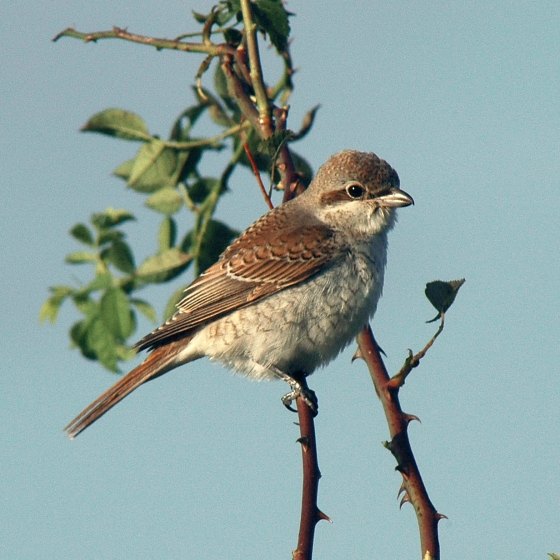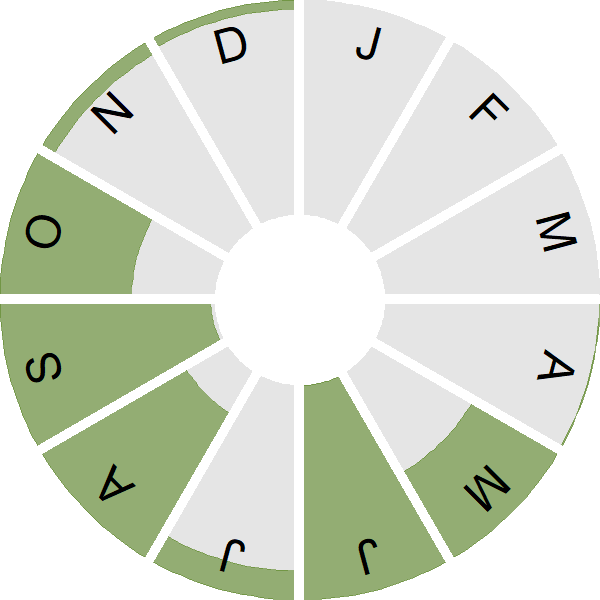Red-backed Shrike

Introduction
Red-backed Shrike was effectively lost as a breeding species in the 1990s, following a longer period of decline. It is now a scarce visitor, most often reported during May to June and August to October.
The loss of Red-backed Shrike from Britain has been linked to changing agricultural practices and habitat loss, because of which populations of favoured large invertebrate prey have been much diminished.

Key Stats
Identification
Songs and Calls
Song:
Call:
Status and Trends
Conservation Status
Population Change
The Red-backed Shrike was a widespread breeding species in the UK but experienced substantial declines during the 19th and 20th centuries and became effectively extinct as a UK breeding bird in 1989, although since 2004 very small numbers have again bred in most years (Davies & Lock 2016). The species is monitored by the Rare Breeding Birds Panel, with a mean of just four breeding pairs reported over the five-year period 2015–2019 (Eaton et al. 2021).
Distribution
During Bird Atlas 2007–11
Occupied 10-km squares in UK
or view it on Bird Atlas Mapstore.
or view it on Bird Atlas Mapstore.
European Distribution Map
Distribution Change
Red-backed Shrikes underwent an extensive range contraction through the late 20th century, dwindling to one pair in the 1990s.
Change in occupied 10-km squares in the UK
or view it on Bird Atlas Mapstore.
Seasonality
Red-backed Shrike is a very rare breeder, with most records relating to passage migrants in May/June and in August to October.
Weekly pattern of occurrence
The graph shows when the species is present in the UK, with taller bars indicating a higher likelihood of encountering the species in appropriate regions and habitats.

Movement
Britain & Ireland movement
Foreign locations of birds ringed or recovered in Britain & Ireland
Dots show the foreign destinations of birds ringed in Britain & Ireland, and the origins of birds ringed overseas that were subsequently recaptured, resighted or found dead in Britain & Ireland. Dot colours indicate the time of year that the species was present at the location.
- Winter (Nov-Feb)
- Spring (Mar-Apr)
- Summer (May-Jul)
- Autumn (Aug-Oct)

European movements
EuroBirdPortal uses birdwatcher's records, such as those logged in BirdTrack to map the flows of birds as they arrive and depart Europe. See maps for this species here.
The Eurasian-African Migration Atlas shows movements of individual birds ringed or recovered in Europe. See maps for this species here.
Biology
Productivity and Nesting
Nesting timing
Egg measurements
Clutch Size
Survival and Longevity
Survival is shown as the proportion of birds surviving from one year to the next and is derived from bird ringing data. It can also be used to estimate how long birds typically live.
View number ringed each year in the Online Ringing Report.
Biometrics
Wing length and body weights are from live birds (source).
Wing length
Body weight
Ring Size
Classification, names and codes
Classification and Codes
- Order: Passeriformes
- Family: Laniidae
- Scientific name: Lanius collurio
- Authority: Linnaeus, 1758
- BTO 2-letter code: ED
- BTO 5-letter code: REBSH
- Euring code number: 15150
Alternate species names
- Catalan: escorxador comú
- Czech: tuhýk obecný
- Danish: Rødrygget Tornskade
- Dutch: Grauwe Klauwier
- Estonian: punaselg-õgija
- Finnish: pikkulepinkäinen
- French: Pie-grièche écorcheur
- Gaelic: Feòladair
- German: Neuntöter
- Hungarian: tövisszúró gébics
- Icelandic: Þyrnisvarri
- Irish: Scréachán Droimrua
- Italian: Averla piccola
- Latvian: (bruna cakste), setas cakste
- Lithuanian: paprastoji medšarke
- Norwegian: Tornskate
- Polish: gasiorek
- Portuguese: picanço-de-dorso-ruivo
- Slovak: strakoš obycajný
- Slovenian: rjavi srakoper
- Spanish: Alcaudón dorsirrojo
- Swedish: törnskata
- Welsh: Cigydd Cefngoch
- English folkname(s): Nine-killer, Flusher
Research
Causes of Change and Solutions
Causes of change
The reasons for the decline in Britain are unclear, although poor breeding performance is not thought to have driven the decline (Tryjanowski et al. 2006). Factors affecting the population may have including agriculatural intensification and hence a reduction in scrubby habitat and large invertebrates, and egg-collecting and other human distrubance; habitat managment and recreation may be important (along with other actions) to increase the likelihood that Red-backed Shrike can recolonise the UK (see review by Davies & Lock 2016). A study of six European populations found that warmer summer weather was correlated with breeding success and hence suggests climate change could possibly benefit the species in the future, although note that the study did not assess the effects of more extreme weather and also cautioned that other factors such as habitat and predation may be more important drivers in some populations (Søgaard Jørgensen et al. 2013).
Publications (1)
Spatial variation in spring arrival patterns of Afro-Palearctic bird migration across Europe
Author: Border, J.A., Boersch-Supan, P., Pearce-Higgins, J.W., Hewson, C., Howard, C., Stephens, P.A., Willis, S.G., Houston, A., Gargallo, G. & Baillie, S.R.
Published: 2024
The timing of migrant birds’ arrival on the breeding grounds, or spring arrival, can affect their survival and breeding success. The optimal time for spring arrival involves trade-offs between various factors, including the availability of food and suitable breeding habitat, and the risks of severe weather. Due to climate change, the timing of spring emergence has advanced for many plants and insects which affects the timing of maximum food availability for migratory birds in turn. The degree to which different bird species can adapt to this varies. Understanding the factors that influence spring arrival in different species can help us to predict how they may respond to future changes in climate.
02.05.24
Papers


